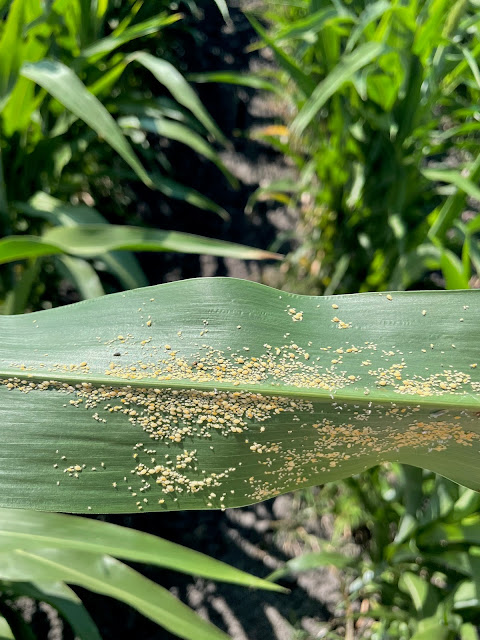Howdy,
We are still dry this week. All of our crops could use the water, although it may be too late for a lot of the corn. Our older cotton is up to match head and 1/3 grown square, and the sorghum is booting to soft dough.
In sorghum we need to be scouting for sugarcane aphid, I've picked it up in sorghum in all three counties in light numbers now. If it's blooming, we need to look for sorghum midge. Here are some links for just sugarcane aphid, and a more recently updated guide for sorghum insect management. Here are links to the threshold calculators for sorghum midge, rice stink bug, and sorghum headworm.
 |
| Sugarcane Aphids in Sorghum Kate Crumley |
In soybeans I started seeing some thrips infestations, I've collected some for identification and will keep everyone updated. Stephen Biles did a test on that a few years ago, and the results of that can be found here. The general estimated threshold for those is 10 thrips per leaflet (not trifoliate), and I've not seen them in that high of numbers yet. I've seen the thrips mostly on the top of the older leaves on soybeans.
 |
| Thrips Injury on Soybeans Kate Crumley |
 |
| Thrips Injury on Soybeans Kate Crumley |
 |
| Thrips on Soybeans Kate Crumley |
Aphids are still in the cotton, but I've been picking up 1 or 2 plants covered in them, and none in the other 25-50 plants checked. We are picking up fleahoppers, and need to be scouting anything with squares carefully for those. Below is my scouting information for the week of 5/20/2022.
 |
| Cotton Aphid Kate Crumley |
The threshold for cotton aphids is 50 aphids per leaf, and if you see aphid mummies in the field (tan or black dry and unmoving aphids), that's a good thing. Parasitoid wasps lay eggs in the aphids, and the aphid forms a mummy while the wasp larvae is pupating inside. These wasps, lady beetles, and lacewings can knock back aphid populations. Treatment for aphids is rarely justified, but if you do decide to treat for aphids, do not use a pyrethroid. Pyrethroids and organophosphates are broad spectrum, and kill beneficial insects as well as your target insect, but pests like aphids bounce back much quicker than their predators do. Their high reproductive rate will allow their numbers to soar after a broad spectrum insecticide application kills all their predators.
 |
| Aphid Mummies on Cotton Kate Crumley |
Spider mite populations rarely get high enough to treat, as they thrive in drier climates and we tend to be fairly humid. Treatment is justified when spider mites are causing visible defoliation.
 |
| Spider Mites on Cotton Kate Crumley |
 |
| Cotton Fleahopper Adult Kate Crumley |
Fleahopper feeding will cause squares to drop. Plants can recover for and compensate for some square loss, but the threshold for fleahoppers is 15-25 per 100 plants. I check for fleahoppers by inspecting the plant terminals once they start squaring. I look at 25 plants per stop in the field, usually checking 100 plants total in an 80-100 acre field, more if the field is larger. Fleahopper nymphs can be close to the size of aphids, but look like smaller versions of the adults without wings, and are much more mobile than aphids.
The chart below contains insecticide suggestions from cottonbugs.tamu.edu (also a good resource) for reference if you have fleahoppers at the action threshold in the upcoming weeks.
I'd also like to let everyone know that there is an Agricultural Pesticide Waste Collection event happening on Wednesday, June 29th from 8:00 am to 12:00 pm at the Victoria County Pct #4 Yard at 226 Beck Road East, Inez, TX 77968. The flyer for that event is below. For any additional questions on this event, please contact the Victoria County Extension Office at (361)-575-4581.
Please check out our weekly IPM Audio Updates, the website to sign up to receive those is listed below. If you have any questions feel free to contact me either by email or calling the office. Have a good weekend, and I hope we get some rain!
Sincerely,
Kate Crumley
Check out our weekly IPM Audio Updates
Cotton Insect Management Guide
Development and Growth Monitoring of the Cotton Plant





No comments:
Post a Comment